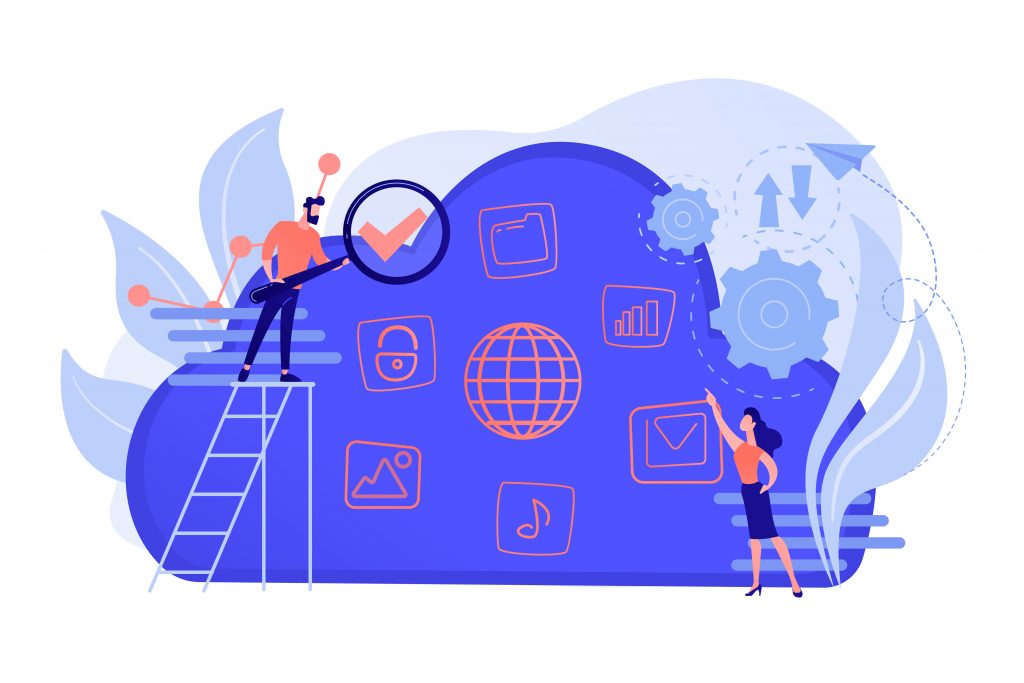The Searchlight guide to Cloud Transformation is built upon our vast experience in managing and driving transformations for firms of all sizes. This blog is the second part of the three-part series. Before diving into this blog on the Cloud Transformation and Implementation, you’ll want to read part one of the guide – “Your Journey to the Cloud”, focused on cloud assessment and planning.

Cloud Transformation & Implementation
Having developed and completed your cloud vision, strategy and business case, you should now have the go-ahead to start the transformation and implementation. To ensure the success of this part of the journey, you should focus on approach, delivery and governance.
Cloud Approach
The cloud approach describes and determines how you are going to achieve the transformation and its goals. To do this you need to make decisions on people, process, technology and data.
People: There are several groups of people you will need to gather, organise, and manage to help you achieve a successful transformation and implementation.
- Stakeholders: All teams and key individuals across your organisation who will be impacted by the journey to cloud should be represented in any discussion or decision that could affect them.
- Programme team: The group of people carrying out the transformation and implementation work itself will likely be a combination of permanent IT & Change staff, seconded business representatives, contractors and consultants. The mix is dependent on what capabilities and capacity you have within your organisation to carry out the transformation. Few companies will have all skills in-house. The blend of external staff will depend on the complexity and duration of the transformation programme team.
- System Integrators: If there are few available internal resources, you may want to consider bringing in an experienced consulting company to run and/or deliver the transformation for you. You should look for a partner who has achieved similar transformations in your section and region, with good references and a clear and measurable set of success metrics.
- Vendors: Whichever technologies you chose to underpin your journey to cloud, you should form a strong relationship with the solution or software provider. This is to ensure that you fully understand the product features and limitations, and that any use of the technology is underwritten by the vendor.
Process: The journey to cloud can introduce new ways of working for many organisations, including the way in which projects and programmes are run.
- Ways of Working: If you don’t yet have experience of working in agile or iterative ways, your cloud journey could be a good opportunity to try out these methods. Agile isn’t as easy as it might appear so be prepared to invest in support and training in these methods.
- Buy vs. Build: Another big approach decision is on whether to buy or build your cloud solutions. If your business requirements are reasonably standard (CRM, resource planning, finance, HR, websites, portals, etc) you should be able to find some Software as a Service (SaaS) solutions that can be easily configured to meet your needs. For more unique requirements, particularly ones that require significant integration with legacy or 3rd party systems, you could consider bespoke development using some standard cloud frameworks and tools.
Technology: Cloud technologies are a very dynamic part of the IT landscape and contain many immature, but exciting, tools and services.
- Choosing the right tech: This can be daunting, as there is a wide choice, from established giants, such as Microsoft and Amazon, to a variety of new start-ups offering innovative capabilities. As part of your Cloud Strategy, you should have agreed a set of architectural and risk principles to help you choose the best balance of cost and risk.
Data: Understanding your business data, its provenance, value, protection requirements, and destination is key to building the right data architecture for the more distributed world of cloud.
- Knowing where and how to master your data: Providing appropriate cyber and legal security is paramount as any data leak or loss can have a significant financial and reputational impact on your organisation.
Top Tip: Few organisations have the experience or skills to embark on a cloud transformation programme, so get some trusted and independent advice from a Cloud Transformation specialist who isn’t trying to sell you tools or IT services.
Cloud Delivery
Once you have lined up your people, process, technology and data resources you are ready to begin the implementation of your cloud journey. The delivery phase of your cloud journey will more likely take either a conventional or an agile route, depending on whether you are primarily going on a buy or build approach.
- Conventional: If you are planning to consume a SaaS business application, you will need to carry out detailed requirements gathering and process modelling to ensure you choose and configure the service to the needs of your organisation. The build stage will be a combination of configuration and integration, followed by the full suite of testing to ensure fit to requirements.
- Agile: For a more dynamic delivery you will need to assemble a mixed business user and developer team that will work together through iterative stages of design, construction and evaluation sprints to evolve from a Minimum Viable Product (MVP) to the full business solution.
Top Tip: Many digital transformations will contain elements that are best suited to either conventional or agile methods. Don’t be afraid to mix and match delivery approaches along your cloud journey.
Cloud Governance
Cloud Transformation journeys can provide significant risk as well as reward to organisations that embark on these ventures. There will be many new elements to the changes you are undertaking across partners, technologies, and methods, that you have not had to deal with before. We would recommend a three-level assurance and governance model to help ensure the Cloud Transformation is successful.
1. Business Assurance: Business process owners and solution leads undertake the 1st line assurance activities, including:
- Reviewing and approving the programme deliverables for each stage of the programme
- Design Authority providing initial and ongoing technical, architectural, and operational assurance through the programme lifecycle
2. Programme Governance: High level overview of all plans, budgeting, progress, quality, scheduling, risks, issues and business dependencies, along with timely and accurate management information. Stakeholders should be proactively engaged on a regular basis to minimise expectation gaps and eliminate unwelcome surprises.
3. Delivery Assurance: External independent delivery assurance focusing on the effectiveness of the programme to adhere to its own quality plan. This provides advice, guidance and coaching before problems occur, and facilitates remedies and mitigations to correct the delivery.
Top Tip: Don’t forget that cloud journeys require more discipline than traditional IT programmes, as they are typically more dynamic with shorter delivery expectations. This makes it imperative to make course corrections along the journey rather than lessons learnt afterwards.
In summary, the journey to Cloud Transformation and implementation requires a mix of adopting new practices along with keeping good governance disciplines to achieve time, cost, and quality goals. Searchlight has helped many organisations achieve their cloud journey by keeping the transformation on track through independent delivery assurance.
In the final article we will describe the optimisation and improvement leg of the journey to cloud. Follow our blog to stay updated!
Contact our team for more information on Cloud Transformations.



